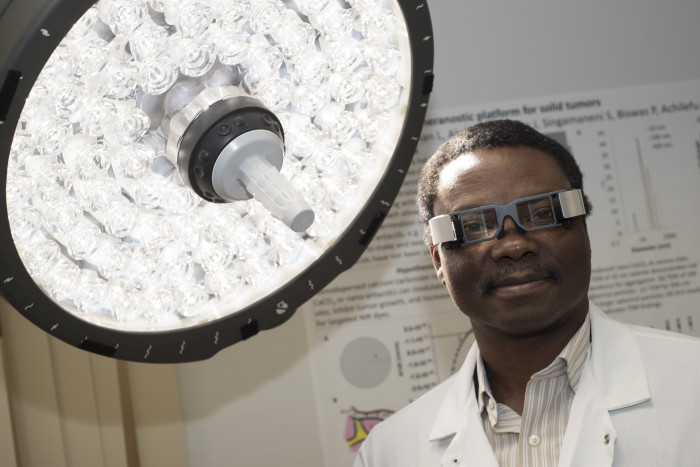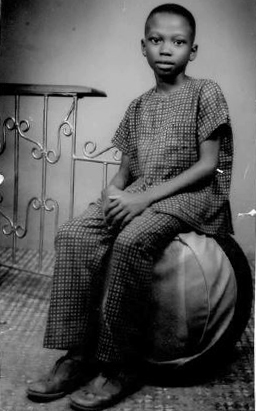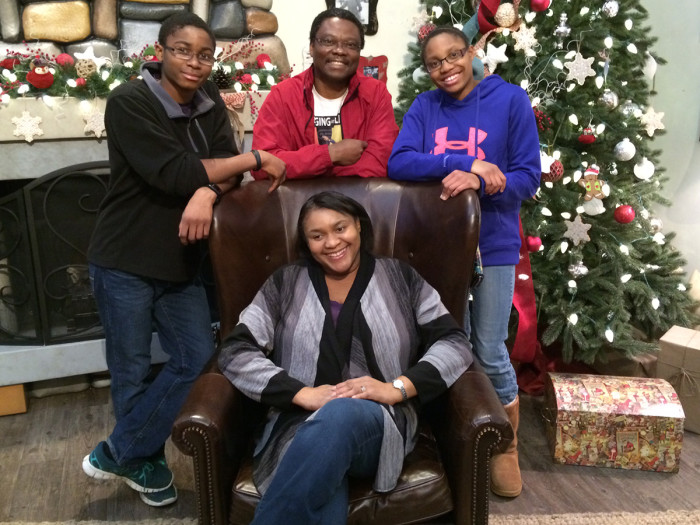Washington People: Samuel Achilefu
Developer of cancer goggles hopes to inspire children in the developing world to pursue their talents
 Robert Boston
Robert BostonSamuel Achilefu, PhD, the Michel M. Ter-Pogossian Professor of Radiology, oversees a variety of cancer-fighting projects. They include development of goggles that help surgeons see and remove cancer and a therapy that uses a combination of light and a photosensitizing drug to kill malignant cells.
They look like futuristic eyewear. But the goggles developed by Samuel Achilefu, PhD, and his team have a much greater purpose: They help surgeons see and remove cancer.
When dye is injected into a patient’s tumor, cancerous cells glow when viewed with the goggles and infrared light. The technology, which awaits further testing, has been used successfully on patients to ensure no stray tumor cells remain after surgery.
Achilefu, who was installed Jan. 28 as the Michel M. Ter-Pogossian Professor of Radiology at Washington University School of Medicine, also is a Siteman Cancer Center research member. He and his wife, Nnena, have been married 21 years. They have a daughter, Chisara, 19, who attends Washington University, and son, Kelechi, 16.
Achilefu, 53, discussed his journey from childhood to the development of his cancer-seeing goggles, to what he hopes is yet to come.
Tell us about your youth.

I was born in northern Nigeria in the 1960s. My dad worked in hospitals and clinics in the northern part of Nigeria until the civil war broke out in 1967. I was only 4 or 5 at the time. We had to migrate from the north to our ancestral home in the east, where our tribe, called the Igbos, live. That’s where we stayed until the civil war ended in 1970.
As a young boy, what did you think of that experience?
You just wondered why you went from having everything to having almost nothing. Fortunately, my uncle housed us and made us comfortable when we migrated back like refugees. It felt weird to go from having a house with a room you call your own to having to share with many people. After about a year, my dad built a house where we settled.
How have your cultural and familial traditions influenced you?
Respect for elders is supreme. We don’t call them by their first names; you have to use a courtesy title. Another tradition I appreciate is the belief that hard work pays off. Nobody’s going to care for you unless you take a step forward on your own. Community service is a virtue I cherish.
You’re a prolific researcher and academic writer. Perhaps that’s another way your culture has influenced you?
My dad was a model for that. I wish he were still alive today. Every day at 5 o’clock he was up. He would do prayer with the family, then do household chores before leaving for work. When he came back, he made sure everybody had their homework done. He was either reading or listening to news or writing. He was the epitome of a smart and hard worker. It was in his DNA. He had an incredible passion for learning. With limited resources, his mom struggled to put him through elementary school in an era when strong and brave youngsters like him were strongly encouraged to hunt and farm. My mom also worked hard. She anchored the family, instilling self-discipline and ethical standards in our lives.
Yes, your mother came from Nigeria last year when you received the St. Louis Award, a recognition of the positive reflection your achievements have had on the community.
Her visit brightened my day when I received the award. During my childhood, my mom carried the burden of raising me. The civil war separated my dad and mom geographically for about 18 months. My mom didn’t know if my dad and elder siblings were alive or dead. It was a terrifying time. She showed strength. We knew she was dying inside, but she never showed weakness by worrying aloud where my dad was or when he would come back. My heart melted when I saw her crying profusely one day. We were dislodged from our home in the east because the area became a war front. We walked for days, trying to find safety somewhere and sleeping in public camps like refugees. She then saw a relative with his entire family in the same camp. That was when she broke down in tears – “Where is my husband and other kids?” God bless her. I’m glad she stayed strong for us.
After the war ended, what was life like for your family?
Many families lost loved ones in the war. We didn’t, and we were grateful for this outcome. As a child, I was aware of the dangers of booby traps everywhere and that a simple trip to the store could be your last. Our family came back together intact. It was a huge relief for me.
My dad was big on education. He wanted to make sure we continued with school. The war delayed everyone by a number of years. I was one of the few fortunate students allowed to jump classes based on performance so I could catch up to where I belonged.
What are some other memories?
We had to make our own toys, which I enjoyed. I also loved the folk stories we heard, playing at night under moonlight, experiencing community life, and learning my native Ibo language. If there is a silver lining at all, the civil war provided me the opportunity to live in a village setting for three years, appreciate the opportunities I have today, and realize that nothing is permanent. I also learned how artistic people can be. They were able to create something out of nothing – baskets from trees and fans from small nylon fibers.
What was your path forward?
I was very fortunate. After attending college in Nigeria, I was one of five Nigerians who received a French government scholarship to attend graduate school in France, where I received a PhD in molecular and materials chemistry at the University of Nancy.
How did radiology enter your plans?
Imaging science was not part of my career plan, which is why I tell our graduate students that a PhD is a license to explore new frontiers in research and teaching. Your initial training is not a confining factor. A PhD represents a higher calling. It’s a doctor of philosophy because we are all philosophers. The training empowers you to believe you can find solutions to larger questions.
Imaging wasn’t in the picture when I did my postdoctoral training at Oxford University in England, either. I trained in the interface between chemistry and hematology, working on developing blood substitutes. The research focused on applying some concepts from my graduate training to design and develop molecules that could efficiently trap and selectively release oxygen for use as blood substitutes in critical-care settings.
In 1993, I arrived in St. Louis after my postdoctoral mentor recruited me to become the first full-time staff member of the Discovery Research Department at Mallinckrodt Medical Inc. It was hard to leave the historic city of Oxford, but I am glad I accepted the opportunity.
What convinced you to come?
First, loyalty – my mentor was so nice to me I couldn’t say no – and then an incredible opportunity. Working in the Discovery Research Department was like working at a university without having to write grant proposals. Naturally, I did not want to move from academia to industry, but my seven-year span there provided me a wealth of unique experiences that have guided my research in academia today.
You’ve said your cancer goggles were partially inspired by tracers on cruise missiles in the Persian Gulf War. Talk about how past experiences can spark a potential solution for a seemingly unrelated problem.
I approach scientific problems by framing them into testable hypotheses. Then I explore different approaches to solve the problem. If additional expertise is needed, I search for the best collaborators to fill the gap. We then design the best experimental method to address the question, guided by our hypothesis. This strategy is not confining; it can be applied in diverse areas of life endeavors. Washington University is a great place for idea incubation and collaboration, opening doors to applying known concepts to new areas of research.
What else are you working on?
I want to play a role in eradicating cancer or making it a manageable disease. Toward this goal, we have developed a new approach to kill cancer cells, independent of the cancer type. There is a method of killing cancer with light – photodynamic therapy. People use it to treat superficial cancers, such as skin cancer, because the cancer has to be reachable by light to activate a light-sensitive drug. Or you can use an endoscope to introduce light to activate and kill cancer cells inside the body. We’ve discovered a new approach of using existing radiopharmaceuticals to create a light source within the tumor cells. The light stimulates the light-sensitive drug in cancer cells, converting them into highly toxic drugs. Meanwhile, negative effects on neighboring healthy tissue are minimized. We have tested this concept with success in animal models of cancer and plan to move into human studies in future.
What nonscientific interests are on your to-do list?
Looking back at my childhood, I remember seeing some exceptionally smart kids in the village school I attended during the Nigerian civil war. But they never had the opportunity to move forward. Can you imagine what the world would look like if they had the opportunity to fulfill their dreams? This thought has haunted me through my adult life. My dad sponsored many students when he was alive. I would like to do the same for college students, but in a different way. I envision creating an institute for global innovation in education and training, with talent searches for smart kids in low-resource areas of the world playing a central role. Depending on resources, a specified number of these kids will be identified yearly for comprehensive training and support through college. Regional centers will allow us to work directly with the locals. I also would like to inspire young ones to attain greater heights. I am sure these events will keep me busy through life!







